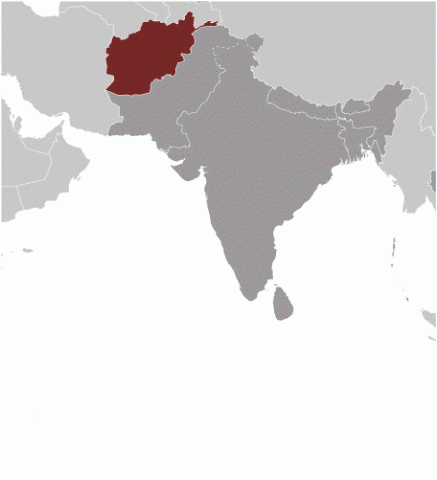Child Labor and Forced Labor Reports
Afghanistan


No Advancement – No Efforts and Complicit in Forced Child Labor
In 2024, Afghanistan is receiving an assessment of no advancement. Afghanistan is assessed as having made no advancement because the Taliban demonstrated complicity in the forced recruitment of children for use in armed conflict. The practice of bacha bazi, which typically entails keeping a boy for the purpose of sexual gratification, has also reportedly continued among influential local leaders, Taliban leaders, and military commanders. The Taliban considered some child trafficking victims, especially those engaged in bacha bazi, as criminals, housing them in juvenile detention centers and subjecting them to physical abuse and other forms of ill treatment rather than referring them to victim support services. The humanitarian crisis following the Taliban takeover in August 2021 resulted in an increase in the prevalence of child labor and exacerbated existing risks for girls. Since September 2021, the Taliban have prohibited Afghan girls from attending public secondary school. The Taliban lack a mechanism for imposing penalties for child labor violations and sufficient programs to address situations of child labor or prevent their occurrence. Moreover, Afghanistan’s laws do not meet international standards, either with regard to the minimum age for work, as they do not apply to workers in the informal sector, or with regard to the prohibition of practices similar to slavery, including debt bondage. In 2024, the United Nations indicated concern that domestic laws pertaining to child protection were not enforced or publicly mentioned by the Taliban and no effort was made to align the country’s child labor protections with international law. References to the Taliban in these findings do not denote or imply that the United States recognizes the Taliban as the Government of Afghanistan.
| Children | Age | Percent and Population |
|---|---|---|
| Working | 5 to 14 | 22% (Unavailable) |
| Boys | 24.5% | |
| Girls | 19.3% | |
| Urban | 10.3% | |
| Rural | 25.6% | |
| Hazardous Work by Children | 15 to 17 | 3.4% (Unavailable) |
| Boys | 6.0% | |
| Girls | 0.8% | |
| Urban | 2.8% | |
| Rural | 3.6% | |
| Attending School | 5 to 14 | 37% |
| Combining Work and School | 7 to 14 | 11.5% |
| Sector/Industry | Activity |
|---|---|
| Agriculture | Herding. Farming, including harvesting poppies. |
| Industry | Working in metal workshops and as tinsmiths and welders.† Construction, including painting. Mining† of coal and salt. Brickmaking† and carpet weaving.† |
| Services | Collecting garbage† and street work, including peddling, vending, shoe shining, carrying goods, and begging. Domestic work. Transporting goods, including across international borders. Repairing automobiles and washing cars. Selling goods in stores, working as waiters in restaurants, and tailoring in garment workshops. |
| Categorical Worst Forms of Child Labor‡ | Forced recruitment of children by the Taliban and other non-state armed groups for use in armed conflict, including for terrorist activities and suicide bombings. Commercial sexual exploitation, sometimes as a result of human trafficking. Use in illicit activities, including in pickpocketing, weapons trafficking, and in the production and trafficking of drugs. Forced labor in the production of bricks, domestic work, and street begging, and for use as assistant truck drivers. |
† Determined by national law or regulation as hazardous and, as such, relevant to Article 3(d) of ILO C. 182.
‡ Child labor understood as the worst forms of child labor per se under Article 3(a)–(c) of ILO C. 182.
Reports indicate that the Taliban demonstrated complicity in the forced recruitment of children for use in armed conflict in 2024. The Taliban typically recruit boys between the ages of 14 and 17, and 97 percent of these recruits become part of the Taliban’s security forces. Some children were coerced or recruited under false promises or fraudulent circumstances. The Taliban do not have a formalized age verification mechanism to ensure that children are not being recruited into their security forces. According to local media sources, in 2024, the Taliban recruited approximately 30 children between 10 and 18 years old in Badakhshan province and provided them with military training in a specialized military training center, including 1 case of forced recruitment.
Children at Higher Risk
Boys in Afghanistan continue to be subjected to commercial sexual exploitation through the practice of bacha bazi, which typically entails keeping a boy for the purpose of sexual gratification. Some boys are sold into the practice by their families. Children subjected to bacha bazi often become further victimized by the threat of violence when returning to their families, necessitating the placement of these child victims in rehabilitation centers; however, research was unable to determine whether sufficient rehabilitation centers existed in Afghanistan to meet this need. The practice of bacha bazi has reportedly continued among influential local leaders, Taliban leaders, and military commanders. High ongoing levels of displacement driven by conflict, extreme weather, economic stressors, and the forced return of Afghan refugees from Pakistan increase the risk of sexual violence against women and girls. Additionally, some girls who are sold into marriage with adult men in order for the girls’ families to obtain dowries end up in commercial sexual exploitation. Children of Afghan families returning from abroad are highly vulnerable to exploitation due to extreme economic hardship, lack of identification papers, and difficulties enrolling in school.
Barriers to Education Access
Children in Afghanistan face significant barriers to education due to poverty and Taliban restrictions on women and girls’ roles in society. Since September 2021, the Taliban have prohibited Afghan girls from attending public secondary school; since December 2022, from attending university; and since December 2024, from receiving medical training, removing the last remaining opportunity for women to pursue higher education. Access to education is further hampered by a lack of identity documents, which particularly affects girls and Afghan children returning from neighboring countries with their families. Since the Taliban banned women from teaching boys, schools face significant difficulties hiring teachers, resorting to hiring men with only high school diplomas or with no formal educational credentials; some teaching positions remain unfilled, leaving children with no instructor at all. The Taliban are also forcing families in some communities to send their children to religious schools created by the Taliban instead of to secular ones. Some teachers speak only Pashto, leaving Dari-speaking children unable to understand lessons. In addition, some Afghan children returning to Afghanistan after having lived abroad do not speak either language, for which there is no accommodation. The practice of teachers and school principals administering corporal punishment discourages children from attending school. Furthermore, the cost of school supplies, textbooks, and transportation prevent some Afghan children from attending school.
| Standard | Age | Meets International Standards | Legislation |
|---|---|---|---|
| Minimum Age for Work | 18 | ✗ | Articles 3 and 13 of the Labor Law |
| Minimum Age for Hazardous Work | 18 | ✓ | Articles 13 and 120 of the Labor Law; Article 613 of the Penal Code; Article 63 of the Law on Protection of Child Rights |
| Identification of Hazardous Occupations or Activities Prohibited for Children | ✓ | List of Prohibited Jobs for Child Laborers; Article 613 of the Penal Code | |
| Prohibition of Slavery, Debt Bondage, and Forced Labor | ✗ | Article 4 of the Labor Law; Articles 510–512 of the Penal Code; Article 37 of the Law on the Elimination of Violence Against Women | |
| Prohibition of Child Trafficking | ✓ | Articles 510–512 of the Penal Code | |
| Prohibition of Commercial Sexual Exploitation of Children | ✗ | Article 18 of the Law on Elimination of Violence Against Women; Articles 510–512, 650, and 652–667 of the Penal Code | |
| Prohibition of Using Children in Illicit Activities | ✓ | List of Prohibited Jobs for Child Laborers; Articles 1, 7, and 23 of the Counter Narcotics Law | |
| Minimum Age for Voluntary State Military Recruitment | 18 | ✓ | Article 4 of the Labor Law; Articles 510–512 of the Penal Code; Article 37 of the Law on Elimination of Violence Against Women |
| Prohibition of Compulsory Recruitment of Children by (State) Military | N/A* | ||
| Prohibition of Military Recruitment by Non-state Armed Groups | ✓ | Articles 510–512 of the Penal Code | |
| Compulsory Education Age | 15‡ | ✓ | Article 17 of the Education Law; Article 609 of the Penal Code |
| Free Public Education | ✓ | Article 17 of the Education Law |
* Country has no conscription
‡ Age calculated based on available information
The Taliban have not made a clear pronouncement on whether they are following modified versions of either Afghanistan’s 1964 or 2004 constitution, or whether they plan to produce a new constitution, making it unclear the degree to which they view relevant protections in the 1964 and 2004 constitutions as remaining in effect. Simultaneously, the Taliban have conveyed that the laws that predate the Taliban takeover of August 2021 remain in effect unless they violate the Taliban interpretation of sharia, as determined by Taliban religious leaders or Taliban-led courts. Reporting indicates that the Taliban have verbally announced the abolition of Chapters 10 and 11 of the Penal Code, which deal with child trafficking crimes and the recruitment and use of children by armed groups, and have further instructed lawyers not to cite the Penal Code in court.
The Republic-era legal framework had several deficiencies with regards to international standards. The Afghan Labor Law’s minimum age provision prohibits those under the age of 19 from being “recruited as a worker.” However, the law defines “worker” as a person who is “recruited based on a definite contract,” meaning that the minimum age provision does not apply to those in informal employment. Afghan law does not sufficiently criminalize practices similar to slavery, including debt bondage. The Penal Code criminalizes the use of male children in bacha bazi, criminalizes forcing children to dance, and criminalizes the forced use of girls in prostitution. However, the legal framework does not criminalize the use of boys or non-forced use of girls in prostitution. Additionally, children in Afghanistan are required to attend school only up to age 15. This standard makes children ages 15 to 17 vulnerable to child labor, as they are not required to attend school but are not legally permitted to work.
| Organization/Agency | Role & Activities |
|---|
| Ministry of Labor and Social Affairs: Responds to complaints of child labor, child trafficking, and child sexual exploitation. Formerly referred cases to the Attorney General’s Office, operated a shelter for human trafficking victims in Kabul, and had a special prosecutor for crimes against children; however, the Taliban closed the Attorney General’s Office in 2023 and replaced it with the so-called “General Directorate for Monitoring and Follow-up of Decrees and Directives.” Research indicates this new “directorate” lacks the investigative role of the Attorney General’s Office. Research was unable to determine whether the Kabul shelter remained in operation. |
| Ministry of Interior: Enforces laws related to child trafficking, the use of children in illicit activities, and child sexual exploitation. Research was unable to determine if any enforcement activities were undertaken during the reporting period. |
| Overview of Enforcement Efforts | 2024 |
|---|---|
| Has a Labor Inspectorate | Yes |
| Able to Assess Civil Penalties | No |
| Routinely Conducted Worksite Inspections | Yes |
| Unannounced Inspections Permitted | Unknown |
| Has a Complaint Mechanism | Unknown |
| Imposed Penalties for Child Labor Violations | Unknown |
| Conducted Criminal Investigations for Worst Forms of Child Labor Crimes | Unknown |
| Imposed Penalties for Worst Forms of Child Labor Crimes | Unknown |
It is unknown how many labor inspectors conducted worksite inspections, or whether child labor violations were found. It is unknown whether investigations into suspected cases of the worst forms of child labor were conducted, prosecutions were initiated, or perpetrators were convicted.
| Coordinating Body | Role & Activities |
|---|
| Child Protection Action Network: Operates as a coalition of agencies, NGOs, and community and religious leaders. Receives complaints of child labor, investigates such cases, refers victims to NGO and government shelters that provide social services, provides case management services, and issues warnings or refers criminal cases to the Attorney General’s Office. It is unclear whether the Child Protection Action Network carried out any activities during the reporting period. |
| Policy | Description & Activities |
|---|
| Labor Policies: The National Labor Policy includes eliminating the worst forms of child labor, such as those involving hazardous activities, enacting of laws prohibiting child labor, and effective enforcement of child labor laws. The National Child Labor Strategy and Action Plan aims to eliminate the worst forms of child labor by 2025 and all child labor by 2030. It also recommends improving social protections and oversight. Research was unable to determine whether this policy is still in force or whether activities were undertaken to implement it during the reporting period. |
| National Anti-Trafficking in Persons Action Plan: Organizes Afghanistan’s response to human trafficking, including bacha bazi, with a three-pronged approach: mandates the National Child Protection Committee to find and respond to bacha bazi cases among Afghan civil servants; encourages the implementation of laws, the prevention of child recruitment into armed conflict, and the reporting of corruption by the Ministry of Defense, the Ministry of Interior, and the so-called “General Directorate of Intelligence;” and oversees the production of annual or semiannual interagency progress reports on addressing trafficking in persons. Research was unable to determine whether this policy was still in force or whether activities were undertaken to implement it during the reporting period. |
| Protection Strategies Related to Child Labor: The National Strategy for Children at Risk creates a framework to provide social services to at-risk children and their families, and guides donors in contributing toward a comprehensive child protection system. Focuses specifically on working children, victims of child trafficking, child soldiers, and other children affected by conflict. The Policy for the Protection of Children in Armed Conflict protects children from recruitment and sexual exploitation in the armed forces and provides services to children rescued from engagement in armed conflict. Assigns the Ministry of Defense and the police with monitoring that children’s rights are safeguarded and coordinates with Child Protection Action Network chapters. Research was unable to determine whether these policies were still in force or whether activities were undertaken to implement them during the reporting period. |
| Program | Description & Activities |
|---|
| Child Protection Units:‡ Units located within police recruitment centers to ensure that children are not recruited to join armed conflict. Operated in all provinces. Prior to the Taliban takeover, Afghanistan did not have sufficient Child Protection Unit reporting channels to identify children, prevent them from joining the security forces, or provide shelter, services, and family reintegration. Research was unable to determine whether Child Protection Units have continued to function after the Taliban takeover. |
‡ Program funded by the Government of Afghanistan prior to the Taliban takeover.
| Area | Suggested Action |
|---|---|
| Legal Framework | Ensure that the minimum age for work applies to all children, including those engaged in informal employment. |
| Criminalize the use of boys and the non-forced use of girls for prostitution. | |
| Ensure that provisions of the Penal Code and the Child Protection Act related to child trafficking and military recruitment and use of children are in effect and enforced. | |
| Criminally prohibit debt bondage. | |
| Increase the compulsory education age from 15 years old to 18 years old to align with the minimum age for work. | |
| Enforcement | Publish information on labor law enforcement efforts, including information about the labor inspectorate’s funding, the number of labor inspectors, the number and type of child labor inspections, the number of violations found, and whether penalties were imposed and collected. |
| Publish information on criminal law enforcement efforts undertaken, including the training of criminal investigators and the number of investigations, prosecutions initiated, convictions achieved, and imposed penalties for violations related to the worst forms of child labor. | |
| Authorize the labor inspectorate to assess penalties and establish implementing regulations for labor inspections. | |
| Ensure that labor inspectors and criminal investigators receive training on child labor. | |
| Establish a mechanism to receive child labor complaints, and ensure that labor and criminal law authorities refer survivors to social services. | |
| Implement a digital tracking system for child labor inspections. | |
| Ensure that victims of the worst forms of child labor are correctly identified as victims and referred to appropriate social services, not arrested, detained, or subjected to mistreatment or physical abuse. | |
| Investigate, prosecute, and, when appropriate, convict and sentence Taliban personnel complicit in facilitating the worst forms of child labor, such as bacha bazi and child soldier recruitment. | |
| Ensure that existing laws and decrees that protect the right of girls to consent to marriage are enforced to prevent forced marriages from being used to facilitate child sex trafficking. | |
| Ensure the investigative and prosecutorial duties of the now-closed Attorney General's Office are carried out. | |
| Establish Child Protection Action Networks in every province with trained staff that can accommodate persons that cannot read or write. | |
| Employ at least 204 labor inspectors to ensure adequate coverage of the labor force of approximately 8.1 million people. | |
| Coordination | Ensure the National Commission on Protection of Child Rights is active and able to carry out its intended mandates, including by holding meetings at the mandated intervals. |
| Policies | Enforce the December 2024 decree stating that human trafficking is incompatible with Islamic law by investigating, prosecuting, and convicting human traffickers and providing reintegration support to trafficking victims, such as reunification with family, shelter, food, and medical care. |
| Implement key policies related to child labor such as the National Labor Policy, the National Child Labor Strategy and Action Plan, and the National Anti-Trafficking in Persons Action Plan, and publish results from activities implemented. | |
| Social Programs | Provide reintegration services and support to returning Afghan families who are at increased risk for labor exploitation, ensuring that children have access to medical care and education. |
| Implement key social programs to address child labor, such as the Asia Regional Child Labor Program, deployment of Child Protection Units of the Afghan National Police, and the administration of Juvenile Rehabilitation Centers, and make information about implementation measures publicly available. | |
| Provide services and other support for internally displaced and returnee girls who are vulnerable to sex trafficking due to inadequate camp facilities, unsafe shelters, and safety issues associated with water collection. | |
| Ensure access to education for all Afghan children, especially girls at all levels and those in rural communities or returning Afghans. Provide children with e-tazkeera national identity cards so they can register for school, and address barriers to education such as corporal punishment, a lack of qualified teachers, a shortage of teachers who speak the language of their students, and the costs of attending school, such as supplies, textbooks, and transportation. | |
| Develop inter-governmental reporting channels for Child Protection Units to identify children, prevent them from joining the security forces, and refer them to shelters, and social, and family reintegration services. |








